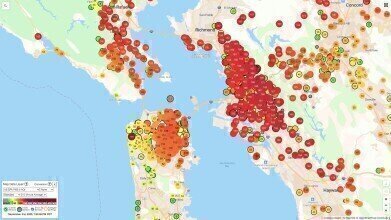Air Monitoring
What Are the 6 AQI Levels?
May 19 2022
Given that air pollution poses a huge problem for public health, governments around the world have introduced an Air Quality Index, better known as an AQI. This sophisticated system assimilates masses of real-time data about the quality of the airways in any given location and presents it in an easy-to-read format, so that users can see at a glance how polluted or how clean the atmosphere in their area is.
Of course, not all AQIs are generated in exactly the same way all over the globe. Some governments use small sensor technology to collect local data and some prioritise different contaminants above others, while the way in which the information is presented to the public can vary as well. For simplicity’s sake, this article will concentrate on the six colour-coded AQI levels as devised by the US system, which is one of the first and most reputable AQIs in the world.
Good – 0 to 50
Colour coded green, any value between 0 and 50 is deemed as having good quality air. This concentration of pollution is regarded as posing little or no risk to human health and as such, people need not alter plans to avoid the affected area.
Moderate – 51 to 100
Air quality which is denoted “Moderate” is marked yellow in colour and accounts for all values between 51 and 100. In this instance, pollution levels are regarded as acceptable and should not be dangerous for healthy individuals. However, those already suffering from pre-existing respiratory conditions may experience some adverse effects.
Unhealthy for Sensitive Groups – 101 to 150
Coloured orange, air quality values of between 101 and 150 are referred to as unhealthy for sensitive groups. This means that vulnerable people (including the elderly, the very young and those with lung conditions) may be negatively impacted by inhaling the air. The general public should not suffer serious consequences from exposure.
Unhealthy – 151 to 200
The red marking on this category is an instant giveaway that it could potentially be dangerous for some members of the population. Accounting for air quality values of between 151 and 200, the “Unhealthy” category could adversely affect anyone and is likely to incur more pronounced health effects in vulnerable groups.
Very Unhealthy – 201 to 300
At this stage, the air quality in a particular region carries a specific health alert. Marked purple, the “Very Unhealthy” level encompasses all values between 201 and 300 and prolonged exposure is likely to result in health implications, while even short-term exposure could have ramifications. As such, the public are advised to avoid such locations.
Hazardous – 301 to 500
The worst level of air quality in the USA is marked maroon and is comprised of all values between 301 and 500. Regarded as “Hazardous”, this category carries an emergency warning and is likely to negatively impact the health of all members of the population. People are strongly advised to make alternative travel arrangements to avoid such pollution hotspots.
This is a brief introduction to the US AQI system, but those interested in learning more about pollution in general are invited to attend this year’s Air Quality and Emissions (AQE) Show in October. Taking place in Telford in the UK, the event will feature a multitude of speakers and exhibitions showcasing the latest developments in the sector.
Digital Edition
IET 34.2 March 2024
April 2024
Gas Detection - Biogas batch fermentation system for laboratory use with automatic gas analysis in real time Water/Wastewater - Upcycling sensors for sustainable nature management - Prist...
View all digital editions
Events
Apr 30 2024 Melbourne, Australia
Apr 30 2024 Birmingham, UK
May 03 2024 Seoul, South Korea
May 05 2024 Seville, Spain
May 06 2024 Minneapolis, MN, USA


















